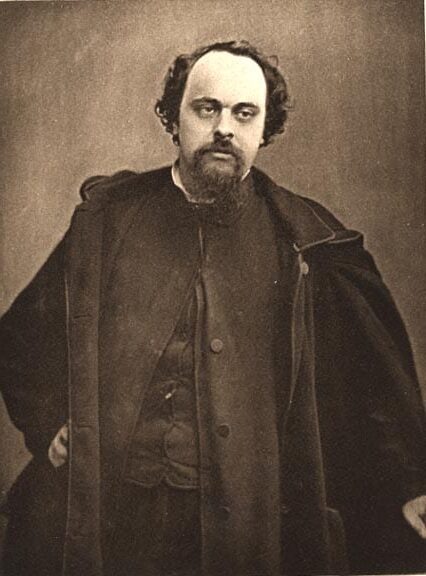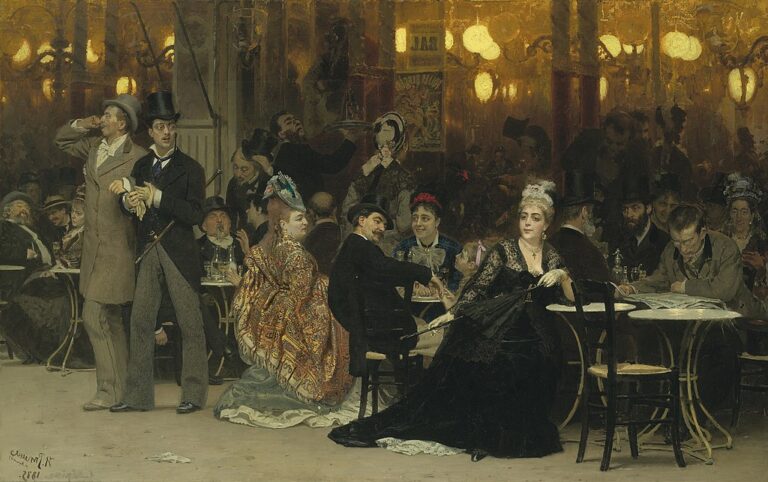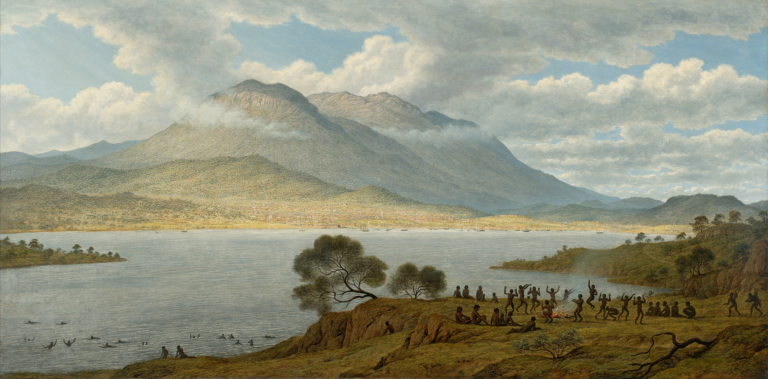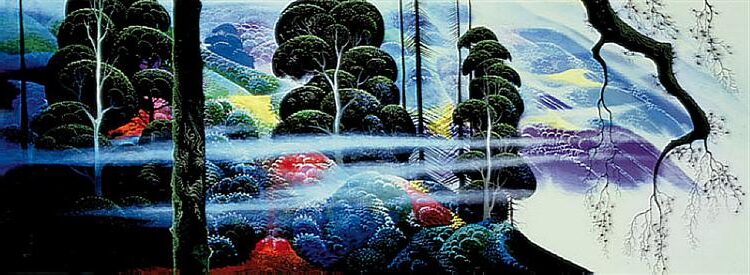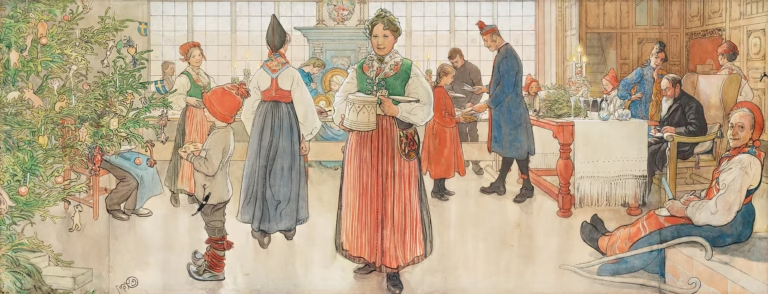Dante Gabriel Rossetti: Painter and Pioneering Figure of the Pre-Raphaelite Movement
Born: 12 May 1828, London, England
Death: 9 April 1882, Birchington-on-Sea, Kent, England
Art Movement: Aestheticism, Early Pre-Raphaelite, Symbolism
Nationality: British
Teachers: Ford Madox Brown and Henry Sass
Institution: King’s College School, Henry Sass’ Drawing Academy, and Royal Academy of Arts
Dante Gabriel Rossetti: Painter and Pioneering Figure of the Pre-Raphaelite Movement
Biographical Sketch of Dante Gabriel Rossetti
Dante Gabriel Rossetti (1828-1882) emerged as one of the most influential figures in Victorian art and literature. As a painter, poet, and founder of the Pre-Raphaelite Brotherhood, he left an indelible mark. His artistic vision combined medieval romanticism with symbolic depth, creating a distinctive style that challenged academic conventions.
Early Life and Education
Dante Gabriel Rossetti was born Gabriel Charles Dante Rossetti on May 12, 1828, in London. He later reversed his first and middle names to honor the Italian poet Dante Alighieri. He was raised in a culturally rich household. His father, Gabriele Rossetti, was an Italian political exile and a Dante scholar.
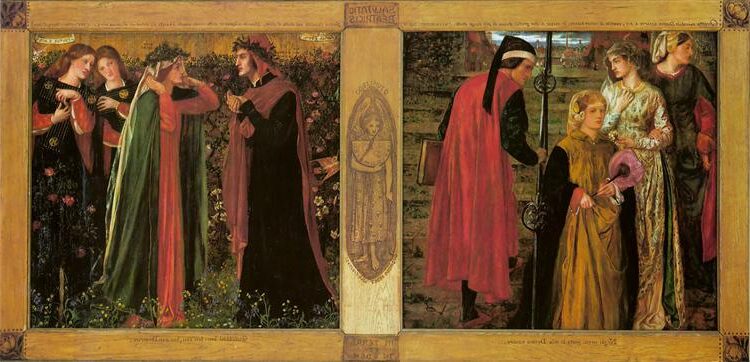
The Salutation of Beatrice 1859 by Dante Gabriel Rossetti
Young Rossetti showed artistic talent early, prompting his enrollment at Henry Sass’s Drawing Academy in 1841. Later, he studied at the Royal Academy Schools from 1845 to 1848. However, he often chafed under formal academic instruction.
His education wasn’t limited to art schools. Rossetti immersed himself in medieval Italian poetry, Gothic romance, and Biblical stories. These themes would later permeate his paintings and poetry.
Formation of the Pre-Raphaelite Brotherhood
In 1848, Rossetti joined with William Holman Hunt and John Everett Millais to form the Pre-Raphaelite Brotherhood (PRB). This revolutionary art movement rejected what they saw as the formulaic approach of the Royal Academy.
The Brotherhood sought to return to the detailed, bright colors, and complex compositions of art before Raphael. Their manifesto demanded truth to nature, authentic emotional expression, and subjects of moral seriousness.
Rossetti’s early PRB works like “The Girlhood of Mary Virgin” (1849) exemplified these principles with their luminous colors, meticulous detail, and religious themes. He recruited other artists into their circle, including Ford Madox Brown, who became an important mentor though never an official PRB member.
The movement faced harsh criticism initially but gained validation when the influential critic John Ruskin defended their work. Ruskin particularly praised Rossetti’s romantic medievalism and symbolic approach.
Significant Relationships and the Muse, Elizabeth Siddal
Elizabeth Siddal became Rossetti’s primary model in 1850, eventually becoming his student, lover, and muse. Her distinctive copper hair and ethereal appearance defined the Pre-Raphaelite feminine ideal in many of his most renowned paintings.

How Sir Galahad, Sir Bors, and Sir Percival Were Fed with the Sanc Grael; But Sir Percival’s Sister Died Along the Way (1864)
Their relationship was tumultuous but passionate. After a lengthy engagement, they married in 1860. Tragically, Siddal struggled with poor health and addiction to laudanum, dying of an overdose in 1862—a loss that devastated Rossetti.
In a dramatic gesture of grief, Rossetti buried a manuscript of his poems with her at Highgate Cemetery. Seven years later, he controversially had her coffin exhumed to retrieve the poems, an act that haunted him with guilt.
Other significant relationships followed, including Jane Morris (wife of his friend William Morris) who became another important muse in his later works, appearing in paintings with her distinctive dark features and sensual presence.
Later Years and Death
The 1860s and 1870s marked a shift in Rossetti’s artistic style. His work became more sensuous and symbolic, focusing on haunting female figures often portrayed in luxuriant settings with rich colors and decorative elements.
His health declined significantly after Siddal’s death. Insomnia and increasing dependence on chloral hydrate (a sedative) and whisky weakened him physically and mentally. Rossetti grew increasingly reclusive, though he maintained relationships with artistic collaborators like Edward Burne-Jones.
In 1871, harsh criticism of his poetry triggered a mental breakdown from which he never fully recovered. By 1882, his physical health had deteriorated severely, leading to kidney failure.
Rossetti died on April 9, 1882, at the seaside town of Birchington-on-Sea, where he had gone to recuperate. He was 53 years old, leaving behind a legacy that would influence art, literature, and aesthetics well beyond the Victorian era.
Artistic Contributions and Style
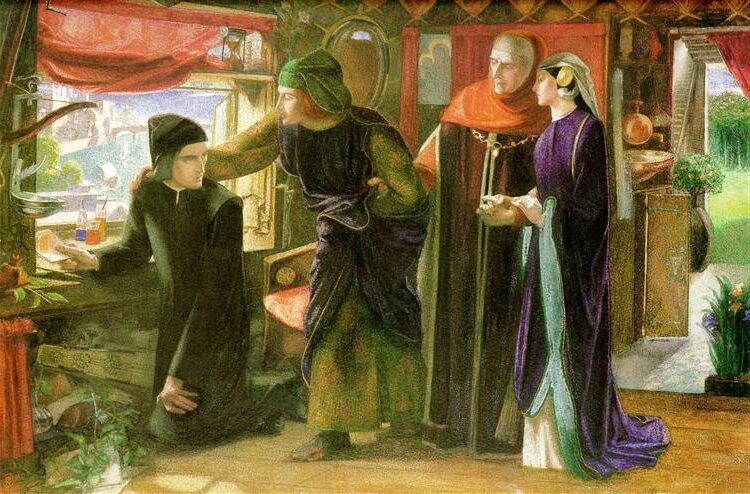
The First Anniversary of the Death of Beatrice (1853) by Dante Gabriel Rossetti
Dante Gabriel Rossetti revolutionized Victorian art through his distinctive fusion of sensuality, symbolism, and literary inspiration. His innovative techniques and subject matter profoundly shaped both the Pre-Raphaelite movement and later aesthetic developments.
The Intersection of Poetry and Painting
Rossetti uniquely combined his talents as both poet and painter, allowing each discipline to inform the other. His paintings often illustrated his own poems, creating a rich dialogue between visual and written expression. “The Blessed Damozel,” existing as both poem and painting, exemplifies this integration.
In works like “Beata Beatrix,” Rossetti’s literary influences shine through his visual compositions. This painting, inspired by Dante Alighieri’s poetry, demonstrates how Rossetti translated poetic imagery into visual form.
His dual artistic identity enabled him to create multilayered works that rewarded deeper contemplation. Viewers familiar with his poetry gained additional context for interpreting his paintings, while his visual art offered new dimensions to his written words.
Prevailing Themes and Symbolism
Rossetti’s art explored recurring themes of love, desire, death, and redemption. His symbolism was intricate and deliberate, with objects and colors carrying specific meanings throughout his work.
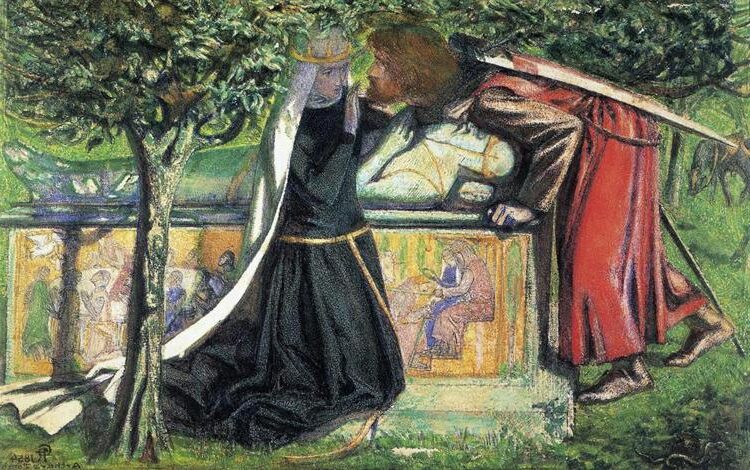
Arthur’s Tomb (1855) by Dante Gabriel Rossetti
Women dominated his canvases, often portrayed as mysterious, powerful figures with distinctive physical features—flowing hair, full lips, and elongated necks. In “Proserpine,” the pomegranate symbolizes captivity and forbidden desire.
Religious imagery appears throughout his early works like “The Girlhood of Mary Virgin” and “Ecce Ancilla Domini” (The Annunciation). These paintings display his interest in spiritual themes while introducing innovations in composition and color.
Natural elements in his paintings—flowers, plants, birds—carried symbolic weight. Rossetti carefully selected these elements to reinforce the emotional and thematic content of each artwork.
Aestheticism and the Pursuit of Beauty
Rossetti championed beauty as an artistic end in itself, helping establish principles that would later define the Aesthetic Movement. His later works emphasized sensuous beauty over moral messaging.
His palette evolved throughout his career, moving from the bright, clear colors of his early Pre-Raphaelite period toward richer, more sumptuous tones. Works like “Bocca Baciata” showcased this shift with its lush colors and decorative elements.
Rossetti’s attention to decorative details—patterned fabrics, ornate jewelry, and elaborate backgrounds—reflected his belief in creating immersive aesthetic experiences. This decorative emphasis influenced both fine art and design.
His studio became a carefully arranged aesthetic environment, filled with exotic objects that often appeared in his paintings. This fusion of art and life embodied his commitment to beauty’s presence in all aspects of existence.
Legacy in British and Victorian Art
Rossetti’s influence extended far beyond his own work. As a founding member of the Pre-Raphaelite Brotherhood, he helped establish artistic principles that challenged academic conventions of the time.
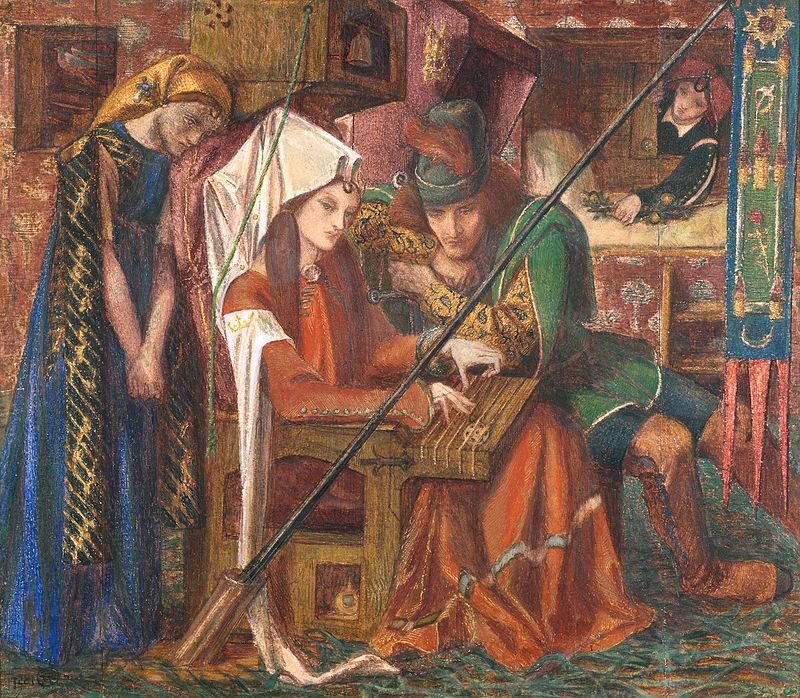
The Tune of the Seven Towers (1857) by Dante Gabriel Rossetti
His mentorship of younger artists like Edward Burne-Jones and William Morris shaped the direction of late Victorian art. These artists carried forward his aesthetic values while developing their own distinctive styles.
“The Seed of David,” his triptych for Llandaff Cathedral, demonstrated his ability to reinterpret religious themes through a distinctly modern sensibility. This approach influenced how sacred subjects were treated in British art.
Rossetti’s emphasis on psychological depth and emotional complexity in portraiture set new standards for depicting human subjects. His sensuous approach to beauty created a pathway for later movements including Symbolism and Art Nouveau.
Noteworthy Works and Influence
Dante Gabriel Rossetti created numerous significant paintings that established his unique artistic vision and shaped future art movements. His work combined medieval romanticism, symbolic depth, and sensual aesthetics that continue to resonate with audiences today.
Masterpieces and Their Interpretations
“The Girlhood of Mary Virgin” (1849) marked Rossetti’s first major oil painting and established his reputation. This work demonstrates his early dedication to “truth to nature” and includes intimate details that reflect Pre-Raphaelite principles.
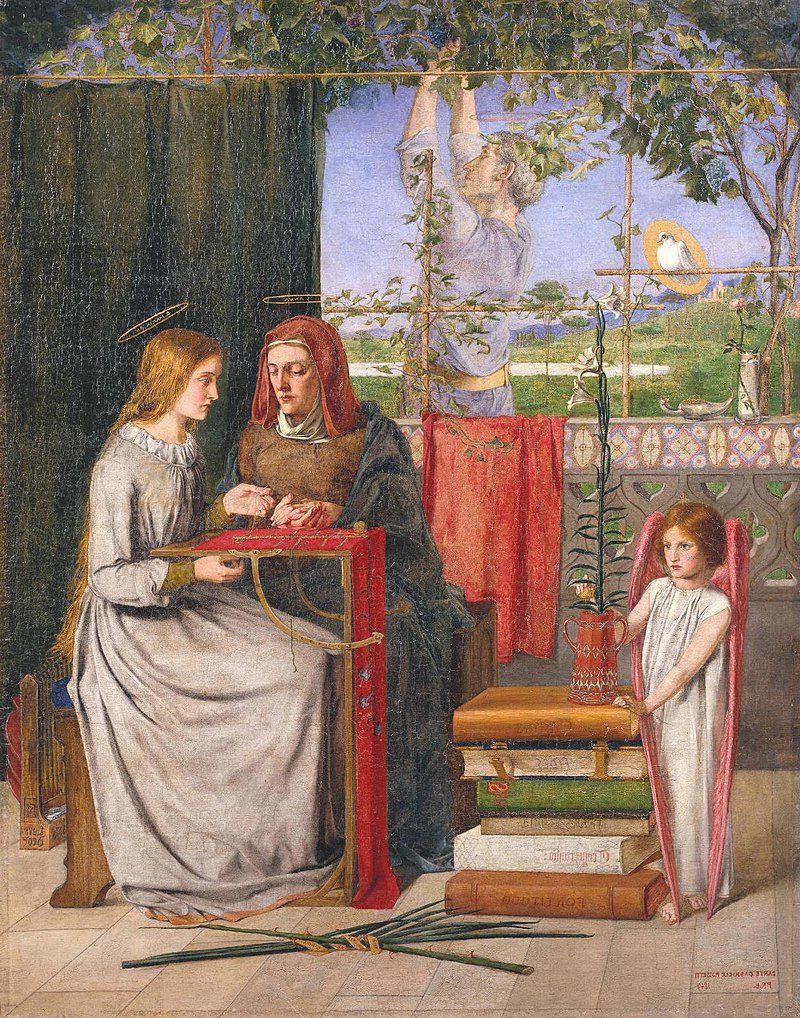
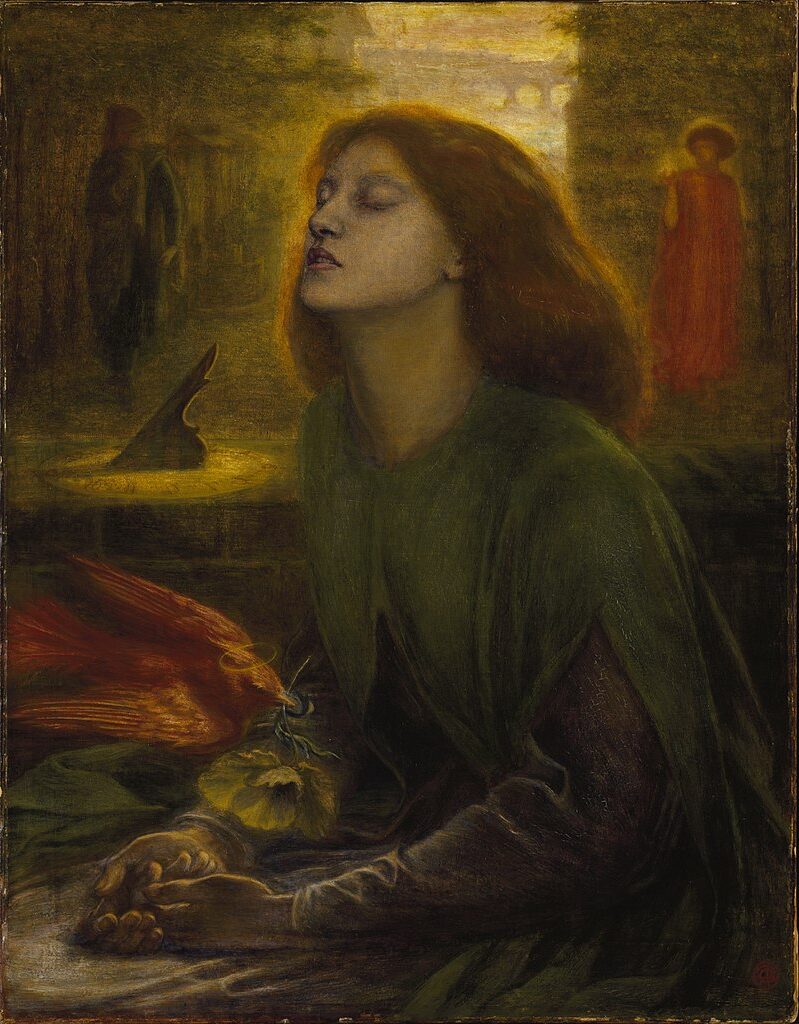
“Beata Beatrix” (1864-70) stands as one of Rossetti’s most recognized paintings. Created after his wife Elizabeth Siddal’s death, it depicts Dante’s Beatrice in a moment of transcendence. The work blends personal grief with literary references, showing his ability to merge emotional depth with symbolic meaning.
“Found” (1854) addresses social issues through the portrayal of a country man discovering his former lover now working as a prostitute in London. Though never completed, this painting reveals Rossetti’s social consciousness.
“Lady Lilith” (1866-68) represents Rossetti’s later fascination with femme fatale figures and sensual beauty. The painting shows his mature style with vibrant colors and symbolic elements.
Influence on Pre-Raphaelite and Aesthetic Movements
Rossetti helped found the Pre-Raphaelite Brotherhood in 1848, establishing artistic principles that valued medieval aesthetics and rejected academic conventions. His work in “The Germ,” the movement’s short-lived journal, helped spread their artistic philosophy.
As Rossetti’s style evolved, he moved from strict Pre-Raphaelite principles toward more sensual aesthetics. This transition influenced the Aesthetic Movement with its emphasis on “art for art’s sake.”
His dual talents as painter-poet created a unique interdisciplinary approach. Rossetti often paired his paintings with sonnets, creating works that engaged multiple senses and demonstrated how different art forms could enhance each other.
His illustrations for poems by Tennyson and others showed how visual art could interpret literature in meaningful ways. This approach influenced book design and illustration practices for generations.
Rossetti’s Impact on Contemporary Art and Culture
The Rossetti Archive preserves his legacy, making his works accessible to modern audiences. This comprehensive digital collection has enabled new scholarship and appreciation of his contributions.
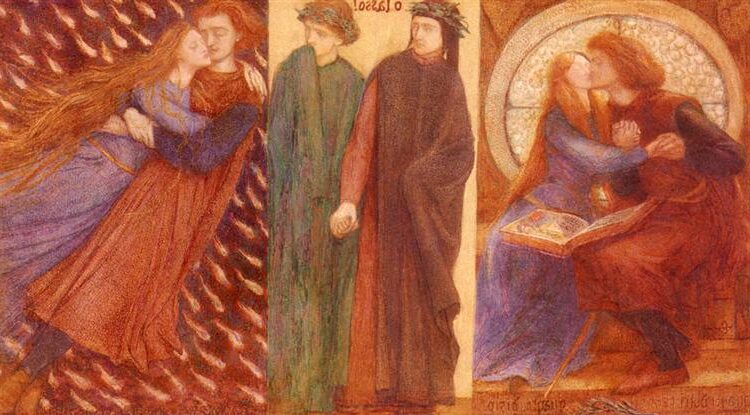
Paolo And Francesca Da Rimini (1855) by Dante Gabriel Rossetti
Rossetti’s integration of poetry and painting influenced multimedia approaches in modern art. His belief in the unity of different art forms anticipated later movements that embraced interdisciplinary creativity.
His distinctive female figures with their sensual yet spiritual qualities created a new feminine aesthetic. This vision of womanhood continues to influence fashion, photography, and contemporary portrayals of women.
Major museums like the Metropolitan Museum of Art feature Rossetti’s works prominently. His paintings command significant attention and have inspired numerous exhibitions focused on Pre-Raphaelite art.
Rossetti’s interest in medieval themes and Italian art helped revive appreciation for these traditions. His translations of early Italian poetry, including works by Dante, introduced these literary treasures to English-speaking audiences.
Frequently Asked Questions
Dante Gabriel Rossetti’s artistic legacy continues to intrigue art enthusiasts and scholars alike. His unique style, significant contributions to Pre-Raphaelitism, and complicated personal history shaped his distinctive artistic output in numerous ways.
What are the most significant influences in Dante Gabriel Rossetti’s painting style?
Rossetti drew inspiration from medieval Italian art and poetry, particularly the works of Dante Alighieri. His early exposure to Italian literature through his father, an Italian scholar, deeply influenced his artistic sensibilities.
Medieval romanticism played a crucial role in shaping Rossetti’s aesthetic vision. He rejected academic conventions of the Royal Academy, instead looking to early Renaissance painters who worked before Raphael.
Religious imagery, particularly Catholic iconography, informed his symbolic approach to art. This spiritual dimension combined with his interest in literary symbolism created his distinctive visual language.
Which paintings are considered Dante Gabriel Rossetti’s masterpieces?
“Beata Beatrix” (1864-1870) stands as one of Rossetti’s most celebrated works. The painting portrays his deceased wife Elizabeth Siddal as Dante’s Beatrice in a haunting, symbolic representation of death as transcendence.
“Proserpine” (1874) featuring Jane Morris holding a pomegranate represents another significant achievement. This work exemplifies Rossetti’s later style with its rich colors and symbolic depth.
“The Blessed Damozel” (1871-1878), based on his own poem, showcases Rossetti’s ability to translate literary themes into visual art. His “Lady Lilith” (1867) and “Monna Vanna” (1866) also rank among his finest paintings.
How did Dante Gabriel Rossetti contribute to the Pre-Raphaelite Brotherhood movement?
Rossetti co-founded the Pre-Raphaelite Brotherhood in 1848 alongside William Holman Hunt and John Everett Millais. His leadership helped establish the movement’s core principles of truthfulness to nature and rejection of academic conventions.
He championed the Brotherhood’s ideals through both his paintings and poetry. Rossetti’s dual talents helped bridge visual art with literature, expanding the movement’s influence across creative disciplines.
Rossetti’s mentorship of younger artists like Edward Burne-Jones and William Morris extended the Pre-Raphaelite aesthetic into the Aesthetic Movement. His emphasis on beauty and medievalism shaped the second phase of Pre-Raphaelitism.
What techniques characterize Dante Gabriel Rossetti’s artwork?
Rossetti employed vibrant, jewel-toned colors that became a hallmark of his style. His palette grew increasingly rich and intense in his later works, creating an almost dreamlike quality.
He often painted without preliminary sketching directly onto canvas, giving his works a distinctive immediacy. His approach to composition frequently featured close-up, intimate portraits with detailed symbolic elements.
Rossetti’s technique evolved from the detailed precision of early Pre-Raphaelitism to a more sensuous, loose brushwork in his mature period. He developed a unique approach to female portraiture that emphasized exaggerated features like full lips, long necks, and abundant hair.
Can you discuss the recurring themes found in Rossetti’s paintings?
Female beauty dominated Rossetti’s artistic vision. He often painted women with distinctive features who embodied both sensuality and spirituality. His models often represented both earthly desire and divine love.
Death and mortality appeared frequently in his work. This fascination with mortality gave his paintings a melancholic undercurrent despite their beauty.
Literary references also permeated his paintings. Rossetti’s work consistently explored the relationship between the spiritual and physical worlds through these literary connections.
How did Dante Gabriel Rossetti’s personal life affect his artwork?
Rossetti’s relationship with Elizabeth Siddal was a major influence on his early work. Her death by suicide in 1862 haunted him, leading to darker themes. This is also when he buried his poetry manuscripts with her.
His later affair with Jane Morris, wife of his friend William Morris, shaped his mature style. Jane became his primary model during this period, embodying a new feminine ideal in his paintings with her distinctive features.
Rossetti’s declining mental health affected his later works. These personal struggles gave his final paintings an increasingly introspective and sometimes troubled quality.


